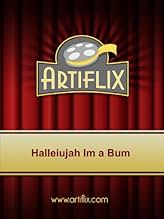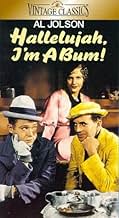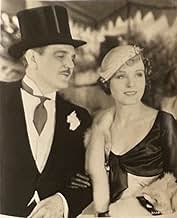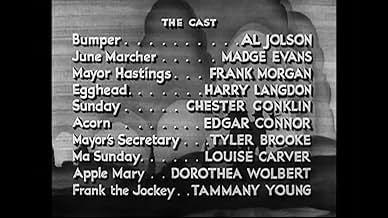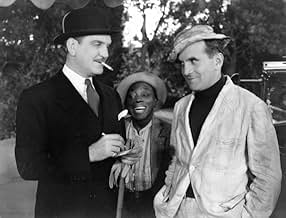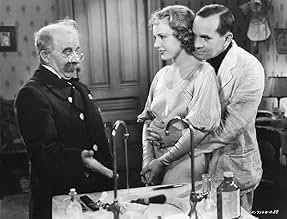A New York tramp (Jolson) falls in love with the mayor's amnesiac girlfriend after rescuing her from a suicide attemptA New York tramp (Jolson) falls in love with the mayor's amnesiac girlfriend after rescuing her from a suicide attemptA New York tramp (Jolson) falls in love with the mayor's amnesiac girlfriend after rescuing her from a suicide attempt
Ernie Adams
- Man Thrown out of Apartment Building
- (uncredited)
Vince Barnett
- Assistant
- (uncredited)
Ted Billings
- Bum with Violin
- (uncredited)
Heinie Conklin
- Bum
- (uncredited)
Gino Corrado
- Mayor's Chef
- (uncredited)
John George
- Bum
- (uncredited)
Harold Goodwin
- Len
- (uncredited)
- Director
- Writers
- All cast & crew
- Production, box office & more at IMDbPro
Storyline
Did you know
- TriviaHallelujah, I'm a Bum (1933), retitled The Heart of New York, was the first Hollywood feature film to be shown on regularly scheduled USA television. It was broadcast by W2XBS, New York City, on 5 July 1939, two months after their inauguration of regular service which had begun on 30 April 1939 with the opening of the New York World's Fair. It is one of over 200 titles in the list of independent feature films made available for television presentation by Advance Television Pictures announced in Motion Picture Herald 4 April 1942. At this time, television broadcasting was in its infancy, almost totally curtailed by the advent of World War II, and would not continue to develop until 1945-1946.
- GoofsA cameraman's arm is reflected in the partially opened window of the Mayor's limousine when the Mayor meets Bumper at the casino.
- Alternate versionsA re-dubbed and edited version (for UK release) called "Hallelujah, I'm A Tramp" frequently turns up on television. In this version the soundtrack is momentarily erased whenever the word 'bum' is sung!
- ConnectionsFeatured in The All Talking, All Singing, All Dancing Show (1973)
Featured review
The best way to appreciate this odd film is to put one's self back in the early 30's, the "Depression era." The drama glamorizes life on the streets and parks, probably to make the ordinary hard-up person feel better about his own financially depressed plight. It also played into the prevailing poverty consciousness of the mass public. Making money seem like something bad, and life on the park bench something wonderful probably appeased and distracted attention from those who were the power-people, calling- the-shots of society. No matter about the lack of human conveniences, just pick a spot in the park and enjoy communing with the birds, squirrels, flowers and trees. Forget about the storms, the cold, the inclimates, it's always fair weather in this film's world. As for Al Jolson, he was a one-of-a-kind entertainer. Sometimes sappy, sometimes, hammy, and other times, sweet and kind--at least in his screen persona. Like him or not, Jolson remains one of the greatest entertainers of the 20th century. Statistics alone prove his status. After knocking 'em dead in hit after hit on Broadway, he was the first to take an entire Broadway production on the road across the country. He was the first to employ a walkway ramp down the center of the theater, cutting out scores of expensive seats. He was the first to make a "talking picture." Then years after being retired and almost forgotten, with loads of young newcomers taking the spotlight -- Jolson came back, making not just a respectable showing, but to the very top of the charts, for two years over Crosby, Como and Sinatra. Never in the history of showbiz has there ever been such an unprecedented comeback. His voice deeper, richer, and more beautiful than ever before, he reigned supreme. And, we dare say, were he to somehow come back today--singing exactly the same songs--he'd be equally as popular and beloved. As his saying goes, "You ain't heard nothin' yet!" The film itself has two lovely songs by Rodgers and Hart: the title song and "You Are Too Beautiful," neither of which is given its full due in the movie. The rest of the film is an oddity, with the charismatic Jolson playing at about half-effort. The legendary Lewis Milestone is the director.
Details
- Release date
- Country of origin
- Language
- Also known as
- Happy-Go-Lucky
- Filming locations
- Pacific Palisades, Los Angeles, California, USA(Central Park scenes)
- Production companies
- See more company credits at IMDbPro
- Runtime1 hour 22 minutes
- Color
- Aspect ratio
- 1.37 : 1
Contribute to this page
Suggest an edit or add missing content


